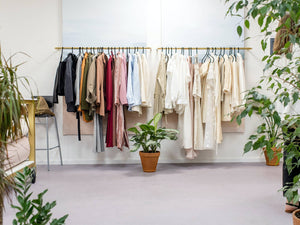What Is Slow Fashion? Slow Fashion: The Sustainable Choice for Conscious Shoppers.
You’ve probably heard about fast fashion. For those not in the know: It’s the rapid production of (mostly) inexpensive clothing in response to the latest trends.
Due to the effort of keeping the cost as low as possible, fast fashion has significant environmental impacts, notably through the extensive use of water and nasty chemicals in the production processes. Their methods sometimes release microplastics and other pollutants into the environment. Did you know that textile dyeing is the second-largest water polluter globally?
What is slow fashion?
Slow fashion, in it’s most basic terms, is quality over quantity. Buying from sustainable sources, and not throwing away your clothes frequently. Choosing slow fashion also comes in hand in hand with ethical production, transparency, and some slow fashion brands even offer a repairs service to give your items another lease of life.
It's a direct response to the fast-paced changes in the fashion industry, encouraging a shift towards more thoughtful, deliberate purchasing and production practices. This approach values quality and craftsmanship, urging consumers and producers alike to consider the entire lifecycle of a garment.
It promotes a deeper understanding of the fast fashion supply chain and its negative effects. Slow fashion is not just about the end product but also about the process of creating garments in a manner that is respectful to the environment, animals and local communities. It aligns with the broader concept of sustainable living, reflecting a mindful and responsible lifestyle choice.
The roots of slow fashion.
Slow fashion originated in the late 20th century. The term "slow fashion" was coined by Kate Fletcher, a British design activist and consultant in 2007. Kat was influenced by "Slow Movement," which began in Italy with Carlo Petrini's Slow Food initiative in the late 1980s.
Although Slow Fashion wasn’t massively popular until the negative impacts of fast fashion became widely known. Concerns about poor working conditions and unfair wages in garment factories, deemed as “Sweatshops” fueled the push towards more ethical and sustainable practices in the fashion industry. Then came the environmental concerns, which added more fuel to the Slow Fashion fire.
Big names like Stella Mcartney, Vivienne Westwood, Patagonia, and Eileen Fisher helped bring Slow Fashion into the public eye through more affordable clothing and high-end fashion.
What if 3RD ROCK were around in the 40's?
What brands are currently practising slow fashion?
There are lots of brands out there who pride themselves on being responsible and ethical. A lot of smaller brands are now needing to embrace slow fashion to stand out amongst the crowd. Some of the leaders of slow fashion are Patagonia, Veja Footwear, and Reformation.
Big brands such as these do well to send the message, but brands like 3RD ROCK show that everyone can and should make the effort to be responsible. You don’t have to be a big brand to be a part of slow fashion. Entering the climbing & outdoor clothing scene in 2010, we’ve pushed the limits and raised the expectation of sustainable, practical and affordable climbing clothing. This has lead other UK brands to do the same, creating a much greener picture in the UK Climbing scene as well as the wider scope.
How can you spot a slow fashion brand?
So you’ve found a brand you like, but are they a good or a bad egg? Best thing to do is take a look into their history and about us page. Try to learn what you can about the production, product materials, clothing certifications and general ethical approach. If you can’t find this, they’re not being very transparent which can be a red flag.
This is also an effective way to spot greenwashing. If a brand isn’t open about their environmental impact, aren’t sharing their manufacturing sources, aren’t open with the fabrics they use and their brand message and values don’t really mention anything about sustainability - chances are they’re not doing their part. If they were why wouldn’t they shout about it.
If fast fashion continues...the future looks pretty bleak.
How can you begin shopping slow fashion?
If you’re looking to begin your slow fashion journey, there’s a few good ways to start.
-
Second hand shopping: Vintage stores, charity shops, and online marketplaces like Vinted are all great ways to start slow fashion. By shopping second hand you’re not adding to the environmental impact of the fashion industry. Plus vintage is so in right now!
-
Building a capsule wardrobe: What the hell is a capsule wardrobe? Basically, a capsule wardrobe is made up of versatile pieces of clothing that can work as multiple outfits. This encourages a more minimalist style.
-
Research your brands: We’ve already mentioned researching a few times in this blog, but that’s because it’s so important! Why wouldn’t you want to know where you clothes come from, right?
-
Shop local: Shopping local boutique brands and independent businesses is a great way to move into slow fashion, also it reduces the environmental impact of shipping goods.
-
DIY & Upcycling: If you’ve got something you’re not a big fan of now, there could be all sorts of ways you can upcycle it to suit your new style. Plus this is really fun, who doesn’t love a crafty Sunday?
What are the difficulties of slow fashion?
While slow fashion has many positive aspects, it's essential to acknowledge that there can be some downsides or challenges associated with this approach.
One of the bigger difficulties with slow fashion is the higher cost. Slow fashion items are often more expensive upfront due to the use of quality materials and ethical labour practices. This can be a barrier for individuals on a tight budget. Check out our article on the true cost of sustainable fashion.
Due to the increased demand for sustainable fashion, more companies are producing more responsible clothing which in turn is bringing the cost down. So the more you shop sustainable fashion the more affordable it will become.
A future eutopia where slow fashion is the norm...that's the goal eh?
Is the future of fashion slow & green?
The future of sustainable clothing looks promising. As the fashion industry continues to respond to environmental and social challenges raised by the news as environmentally conscious individuals like you!
As sustainability becomes an integral part of fashion culture as well as day to day life, innovation from both small and bigger brands will continue, and are likely to shape a more ethical and environmentally friendly future for the clothing industry.
To wrap it up (in plastic free packaging 😉)
Right now, slow fashion stands as a beacon of hope in an industry marred by the negative impacts of fast fashion.
By putting sustainability, ethics, and transparency above all else, slow fashion brands have shown the fast fashion industry that it works - people genuinely care about their clothing and where they’ve come from. We’re not ahead of them just yet, there’s still some catching up to do - but look out fast fashion; we’re coming for you!
We’re the tortoise, and you’re the hare…let’s race!
For more awesome blogs and news like this, join our newsletter!
Feb 01, 2024



